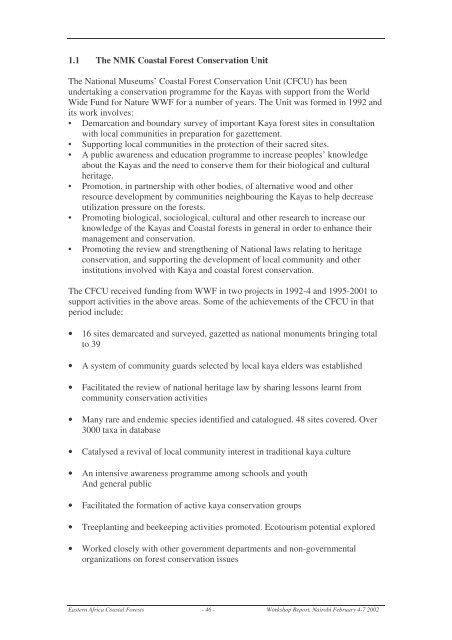Eastern Africa Coastal Forest Programme: Regional Workshop ...
Eastern Africa Coastal Forest Programme: Regional Workshop ...
Eastern Africa Coastal Forest Programme: Regional Workshop ...
You also want an ePaper? Increase the reach of your titles
YUMPU automatically turns print PDFs into web optimized ePapers that Google loves.
1.1 The NMK <strong>Coastal</strong> <strong>Forest</strong> Conservation Unit<br />
The National Museums’ <strong>Coastal</strong> <strong>Forest</strong> Conservation Unit (CFCU) has been<br />
undertaking a conservation programme for the Kayas with support from the World<br />
Wide Fund for Nature WWF for a number of years. The Unit was formed in 1992 and<br />
its work involves:<br />
• Demarcation and boundary survey of important Kaya forest sites in consultation<br />
with local communities in preparation for gazettement.<br />
• Supporting local communities in the protection of their sacred sites.<br />
• A public awareness and education programme to increase peoples’ knowledge<br />
about the Kayas and the need to conserve them for their biological and cultural<br />
heritage.<br />
• Promotion, in partnership with other bodies, of alternative wood and other<br />
resource development by communities neighbouring the Kayas to help decrease<br />
utilization pressure on the forests.<br />
• Promoting biological, sociological, cultural and other research to increase our<br />
knowledge of the Kayas and <strong>Coastal</strong> forests in general in order to enhance their<br />
management and conservation.<br />
• Promoting the review and strengthening of National laws relating to heritage<br />
conservation, and supporting the development of local community and other<br />
institutions involved with Kaya and coastal forest conservation.<br />
The CFCU received funding from WWF in two projects in 1992-4 and 1995-2001 to<br />
support activities in the above areas. Some of the achievements of the CFCU in that<br />
period include:<br />
• 16 sites demarcated and surveyed, gazetted as national monuments bringing total<br />
to 39<br />
• A system of community guards selected by local kaya elders was established<br />
• Facilitated the review of national heritage law by sharing lessons learnt from<br />
community conservation activities<br />
• Many rare and endemic species identified and catalogued. 48 sites covered. Over<br />
3000 taxa in database<br />
• Catalysed a revival of local community interest in traditional kaya culture<br />
• An intensive awareness programme among schools and youth<br />
And general public<br />
• Facilitated the formation of active kaya conservation groups<br />
• Treeplanting and beekeeping activities promoted. Ecotourism potential explored<br />
• Worked closely with other government departments and non-governmental<br />
organizations on forest conservation issues<br />
<strong>Eastern</strong> <strong>Africa</strong> <strong>Coastal</strong> <strong>Forest</strong>s - 46 - <strong>Workshop</strong> Report, Nairobi February 4-7 2002
















